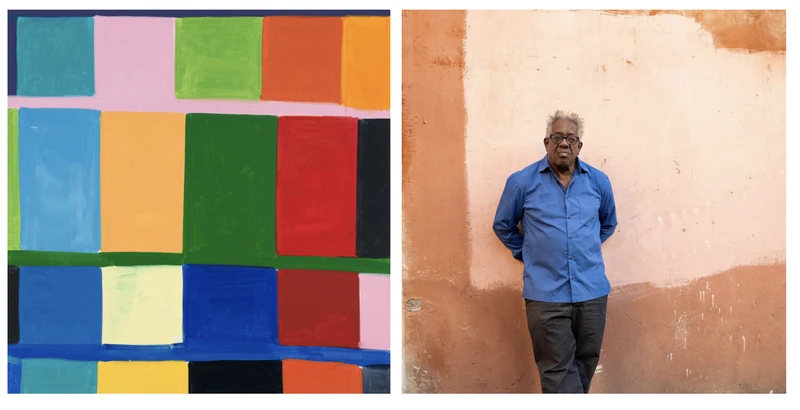Stanley Whitney


b. 1946, United States
Stanley Whitney was born in 1946 in Philadelphia, and lives and works in New York and Parma, Italy.
I follow the paintings wherever they take me. If the painting goes out the door, I follow it out the door; if it goes out the window, I follow it out the window.
—Stanley Whitney
“I start at the top and work down,” explains Stanley Whitney. “That gets into call-and-response. One color calls forth another. Color dictates the structure, not the other way round.” Whitney’s vibrant abstract paintings unlock the linear structure of the grid, imbuing it with new and unexpected cadences of color, rhythm, and space. Deriving inspiration from sources as diverse as Piet Mondrian, Giorgio Morandi, and American quilt-making, Whitney composes with blocks and bars that articulate a chromatic call-and-response in each canvas. He has spent many years experimenting with the seemingly limitless potential of a single compositional method, loosely dividing square canvases into multiple registers. The thinly applied oil paint retains his active brushwork and allows for a degree of transparency and tension at the overlapping borders between each rectilinear parcel of vivid color. In varying canvas sizes, he explores the shifting effects of his freehand geometries at both intimate and grand scales as he deftly lays down successive blocks of paint, heeding the call of each color. Experimental jazz—Charlie Parker, Miles Davis, Ornette Coleman—is Whitney’s soundtrack, its defining improvisational method yielding ever new energies to his process of painting.
Whitney was born in Philadelphia in 1946 and studied at the Kansas City Art Institute before moving to New York City in 1968. He graduated with an MFA from Yale School of Art in 1972, but found himself at odds with the politically and theoretically oriented contemporary scene of the 1970s and 1980s, confronting the expectation that an African American artist should contend directly with themes of racial and cultural identity. Whitney was more interested in honing an abstract visual language, his early works incorporating patches of color surrounded by areas of empty space. At this stage in his career he was also focused on the power of gesture and immersed in the daily practice of drawing.
Although Whitney has been deeply invested in chromatic experimentation throughout his career, he consolidated his distinctive approach during a period spent living and working in Rome in the 1990s, shifting his compositions from untethered amorphous forms to the denser stacked arrangements that characterize his mature style. It was Roman art and architecture—including the imposing façades of the Colosseum and the Palazzo Farnese and the stacked shelves of funerary urns on display at the Museo Nazionale Etrusco—that informed his nuanced understanding of the relationship between color and geometry. Italy remains a central and enduring source of inspiration for Whitney, who spends his summers painting at his studio near Parma.
Yet while the dynamics and characteristics of Whitney’s application make reference to basic architectural structures, his light, free, and rapid application subverts any implication of gravity. Reveling in the improvisational alchemy at play in his compositions, Whitney also skirts any claim to a personal theory of color: “I like to leave it as pure magic,” he states. “People say the color does this, or the color does that. And I say the color does what it does.”
Whitney lives and works in Bridgehampton, New York, and Parma, Italy, and is currently Professor Emeritus of Painting and Drawing at Tyler School of Art and Architecture, Temple University, Philadelphia. His work is included in public collections including those of the Metropolitan Museum of Art, New York; Whitney Museum of American Art, New York; Philadelphia Museum of Art; High Museum of Art, Atlanta; and National Gallery of Canada, Ottawa. Dance the Orange, a retrospective of his work, opened at the Studio Museum in Harlem, New York, in 2015; he has also had solo exhibitions at institutions including the Modern Art Museum of Fort Worth, Texas (2017), and Palazzo Tiepolo Passi, Venice, Italy (2022). In 2017 he participated in Documenta 14 in Athens and Kassel, Germany.